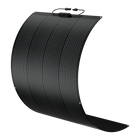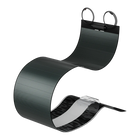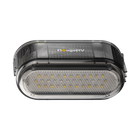What Is Bifacial Solar Panel? How Does It Work?


Unlike traditional solar panels, bifacial solar panels absorb sunlight from both sides, boosting energy output and efficiency. Delve into the structure, working, efficiency, and cost of these innovative solar panels. We also compare them with Monocrystalline panels and explain their suitability for various installations, outlining their advantages and downsides.
Whether you're considering solar energy for residential or commercial use or camping, our comprehensive guide shows you all the information you need about bifacial solar modules!
What Are Bifacial Solar Panels?
Bifacial solar modules are a type of solar panel capable of generating electricity from both sides. In contrast to traditional monofacial solar panels, which only capture sunlight from the front side, bifacial solar panels can also utilize the light reflected or scattered from the rear side. This means that bifacial solar panels can produce more energy than monofacial ones, especially in conditions where the back side receives a lot of light, such as on snowy ground or highly reflective rooftops.
Bifacial Solar Cell Structure
Bifacial solar cells are photovoltaic solar cells that can produce electricity when illuminated on front or rear surfaces. The solar cells are sandwiched between a layer of glass and a transparent backsheet, or between two layers of glass, forming a bifacial solar panel.
Bifacial solar panels are typically made from Monocrystalline cells. Some bifacial solar panels have frames, while others are frameless. What remains consistent is their ability to generate electricity from both sides.
How Do Bifacial Solar Panels Work?

Bifacial solar panels work by absorbing direct and diffuse sunlight from the front side, as well as reflected and scattered light from the rear side. The amount of light that reaches the rear side depends on the albedo, which is the ratio of reflected light to incident light. The higher the albedo, the more light is available for the rear side.
For example, snow and white surfaces have a high albedo of about 80%, while grass has a low albedo of about 25%. This means that your bifacial solar panels installed on snowy or white surfaces can produce more electricity than when they are mounted on grass, assuming that the season, time of day, and weather conditions remain the same.
Bifacial Solar Panel Efficiency
Bifacial solar panels are significantly more efficient at capturing sunlight than monofacial panels. Generally, bifacial solar panels can increase the solar energy yield by 5% to 30% compared to monofacial solar panels.
When installed on highly reflective surfaces such as white TPO roofs, white RV roofs, or on the ground with light-colored stones, some bifacial solar panels claim up to a 30% increase in power output. Bifacial solar panels are particularly useful in certain applications, such as sun-tracking systems.
However, the efficiency of bifacial solar modules depends on several factors, including the cell type, panel design, installation angle, and height, location and climate of the installation site, and shading and dirt on the panel.
Bifacial Solar Panel Price
On average, the cost per watt for bifacial solar panels is around $1.2 per watt. This means that a 200-watt bifacial panel will cost you approximately $240. The exact price per watt for bifacial solar panels can vary from one brand to another.
In the United States, the average price for mounting bifacial solar panels falls in the range of $6,000 to $12,000. Most homeowners typically spend an average of $8,000 to purchase ten bifacial solar panels installed in a porch cover pattern.
Bifacial Solar Panels Advantages and Disadvantages
Bifacial solar panels offer both advantages and disadvantages compared to monofacial ones.
Advantages of Bifacial Solar Panels
-
Higher energy yield and efficiency. Bifacial solar panels can produce more electricity than monofacial ones by utilizing both sides of the panel. For example, BougeRV's bifacial solar panels can generate 30% more energy than monofacial solar panels. This means you can install fewer solar panels to meet your energy needs, enhance the return on your investment, and reduce the payback period of the system.
-
More reliable and durable. Bifacial solar panels have lower degradation rates and higher resistance to potential induced degradation (PID) than monofacial ones. This can extend their lifespan and warranty period. Bifacial solar panels often come with a longer warranty of up to 30 years.
- More flexible and versatile. Bifacial solar panels can be installed in various applications and environments where monofacial ones may not be suitable or optimal. For example, bifacial solar panels can be used for commercial and utility-scale projects with large open spaces and high albedo, such as deserts, fields, or parking lots.
-
More aesthetically pleasing. Bifacial modules come in many designs, including frameless options. Many people find the complete glass frame more aesthetically pleasing compared to monofacial solar panels.
-
Bifacial solar modules also have the advantage of reducing their working temperature via their glass composition channels.
Disadvantages of Bifacial Solar Panels
-
Higher installation complexity and cost. Bifacial solar panels need special mounting systems and inverters that can handle the dual-sided power output. They also need more space between rows to prevent shading and allow enough light to reach the rear side.
-
Higher maintenance and cleaning. Bifacial solar panels need more frequent and thorough cleaning to remove dust and dirt from both sides. This could increase labor costs, especially for large-scale bifacial solar systems.
Bifafacial Solar Panels vs. Monocrystalline Solar Panels
The only real difference between bifacial solar panels and Monocrystalline ones lies in how the panel is constructed. While traditional Monocrystalline solar panels feature an opaque back sheet, bifacial solar panels boast a transparent back or dual glass panel that holds the solar cells in place.
Monocrystalline refers to the type of silicon material used to make solar cells, while bifacial pertains to the ability to generate electricity from both sides of the panel.
One of the noticeable physical features of bifacial panels is their slim appearance, as many bifacial panels have limited framing. Bifacial panels are designed to maximize the usage of their front and back surfaces, requiring minimal shaded areas to capture maximum energy. Therefore, bifacial panels employ compact junction boxes, slender support rails, and vertical supports at the corners of the mounting system, all aimed at minimizing shading on the rear side of the panels.
Which Is Better, Bifacial vs. Monofacial?

Bifacial solar panels can absorb light from both sides and take up less space. With their larger surface area for sunlight absorption, bifacial solar panels produce more power and outperform traditional panels in terms of efficiency, especially when installed on highly reflective surfaces and at low tilt angles.
Depending on the brand, bifacial solar panels might have higher upfront costs and may entail additional mounting costs, but they can also offer a lower LCOE and a shorter payback period. They might also require solar tracking systems, which can add to the overall expense.
Bifacial Solar Panels for Commercial and Utility-Scale Solar Projects
Bifacial solar panels are best suited for commercial and utility-scale solar projects, especially those using solar trackers. They can increase energy output in large-scale solar installations by efficiently absorbing energy from both sides of the panel.
In commercial solar systems, where solar panels are installed above the ground, sunlight hitting the ground below the panel can bounce back and be captured by the rear-facing solar cells. Lighter-colored surfaces such as sand tend to reflect more sunlight compared to darker surfaces like asphalt, soil, or grass.
Use Bifacial Solar Panels for Residential Installations
Bifacial solar panels often come with a higher cost compared to traditional Monocrystalline or polycrystalline panels, making them most suitable for larger solar projects that facilitate efficient collection of reflected light.
But, there are quality affordable bifacial solar panels great for residential rooftop solar setups. For instance, BougeRV’s 200W bifacial solar panels are less expensive than their Monocrystalline counterparts while offering higher efficiency. They are affordable and great for home setup. Standalone structures like pergolas can also benefit from these bifacial panels, offering both shade and energy generation.
Are Bifacial Solar Panels Worth It?
Bifacial solar panels are a worthwhile investment if you're planning to maximize your energy output and savings from your solar system. However, they aren't necessarily superior to monofacial ones in every situation. It's important to consider your specific needs, budget, location, and preferences before investing in bifacial solar panels for your system.
Buy the Best Bifacial Solar Panels From BougeRV

At BougeRV, we provide high-efficiency 200W and 100W bifacial solar panels made with Monocrystalline 10BB solar cells that generate 30% more power output. Equipped with a Junction box and connectors, it’s a breeze to wire our bifacial solar modules. Our bifacial solar panels can be set up for both residential use and your RV trip.
Conclusion
So far, we've clarified what bifacial solar panels are, how they work, and their pros and cons. Bifacial solar panels produce more electricity by absorbing sunlight from both sides and they are ideal for installations with high albedo. Their increased power output and durability make them economically advantageous for you over the long term.
Decided to add bifacial solar panels to your setup? Check out BougeRV's highly efficient bifacial solar panels for more details!
FAQs
1. What Are the Cons of Bifacial Solar Panels?
Bifacial solar panels involve additional mounting work and upfront costs due to the requirement for specialized mounting systems. Additionally, they need more space between rows to prevent shading. These factors can increase initial installation costs but may pay off in the long run with increased energy generation.
2. When Should You Use Bifacial Solar Panels?
Bifacial models utilize the albedo effect to capture more sunlight from reflective surfaces, such as the ground, on their rear side. They are perfect for installations where the back of the solar array can absorb reflected light, including systems mounted on the ground, solar carports, and canopies.
3. Can You Use Bifacial Panels on a Roof?
Bifacial panels can be a great addition to your roof. Not only are these panels more efficient because they capture sunlight from both sides, but they also offer an aesthetic advantage with their sleek and modern design.
If you have a highly reflective roof, such as white or metal roofing, the backside of the bifacial panels will effectively capture the reflected light and convert it into electricity. You can save on the total number of panels needed, thereby saving space and money.
4. How Are Bifacial Modules Installed?
Bifacial solar modules are mounted similarly to monofacial panels. However, due to their unique design, they need to be installed on elevated racking systems at an optimal tilt angle, and with enough space between rows to avoid shading. This allows light to hit the rear side of the solar panels.








































